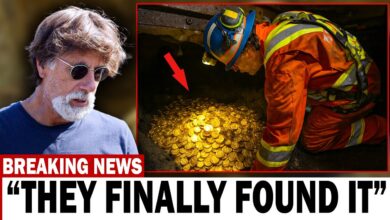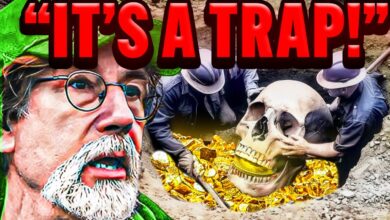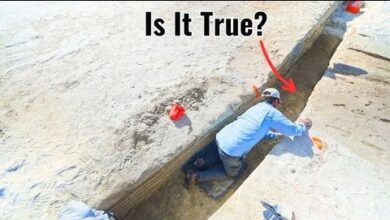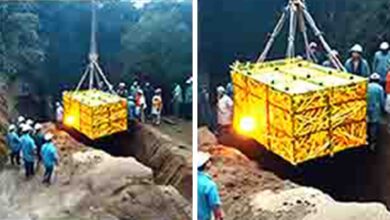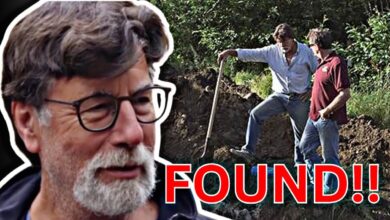“A Way Into the Money Pit?!” *AMAZING FIND* (Season 12) | The Curse of Oak Island
"A Way Into the Money Pit?!" *AMAZING FIND* (Season 12) | The Curse of Oak Island

In the northern region of the triangle-shaped swamp…
The deeper boards are -in much better shape.
ALEX: Yeah.
NARRATOR:
…Rick Lagina has joined his nephew Alex and other members of the team, where they are searching for other additional possible caches of buried valuables.
(clanking)
(clanking)
Wait, wait, wait, wait, wait, wait, wait, wait.
What’s that thing?
Look at that.
A piece of shaped wood.
KATYA: Really?
ALEX: Yeah.
It was roughly three feet deep.
BILLY: Yes, it is. Yeah.
RICK:
That’s definitely worth keeping.
ALEX: Yeah.
RICK:
Stylistically, Laird might be able to tell us the date.
ALEX:
Yeah. Should be identifiable.
It’s unique, that’s for sure.
NARRATOR:
Shaped wood?
Found some three feet deep underground in the swamp?
Could it be related to the structure that the team discovered much closer to the surface?
Or perhaps another one further below?
RICK:
What is this piece of wood doing at this depth?
I mean, this is quite deep for anything to be there.
But it’s suggestive, certainly, of the possibility of multiple treasure caches.
But at the end of the day, you have to hold the proof in your hand and keep eyes on target.
BILLY:
The one thing we’re sure is that we continue to show that people were working in the swamp for something, right?
The boards didn’t get there on their own.
RICK:
Right. Well, it certainly continues to remain of interest, right?
So, let’s finish this little area.
ALEX: Okay.
RICK:
And hopefully we’ll find some answers, not just questions.
ALEX: Okay.
NARRATOR:
As the excavation continues in the swamp, on Lot 5…
JACK:
Hey, Fiona.
FIONA:
Hello, Jack.
So, how’s progress on this test pit coming?
This is actually a really interesting pit.
NARRATOR:
…Jack Begley joins archaeologist Fiona Steele and her assistant Todd Langseth as they continue to investigate a mysterious, round foundation near the shoreline.
The whole point of this test pit is to see if it’s an entranceway.
There’s a gap in the rocks.
And the bonus tie-in is that this is the one area of the entire structure that we found that Money Pit soil.
NARRATOR:
While meticulously uncovering this foundation over the past two years, the team has discovered man-made mortar that matches soils from more than 100 feet deep in the Money Pit area.
Additionally, they have unearthed multiple sections of the feature, along with an array of coins and artifacts that, incredibly, have been dated to between the 14th and 18th centuries.
FIONA:
What spot would you like me to start at?
If you don’t mind starting through here– you can see where it’s higher– that would be really, really helpful.
NARRATOR:
These discoveries have made the team suspect that the feature was used and modified by different groups over a number of eras when treasure may have been deposited in the Money Pit area.
FIONA:
Oh.
So, look at that.
I think it’s a hinge piece.
JACK:
Wait. What is it?
FIONA:
Well, if you look at it, it’s triangular, and if this piece flaps over, it was probably a small hinge.
JACK:
What type of a hinge would that be?
‘Cause it doesn’t look like it’d be that big for, like, a front door.
It just wouldn’t have been a very big door.
Or a hinge to a box or a chest.
We can’t rule that out, either. Hmm.
NARRATOR:
Could Jack Begley’s suspicion that this hinge might have come from a box or chest be correct?
If so, where is the rest of it, as well as its contents?
TODD:
We should bag it.
JACK:
Yeah. That’s exactly the type of thing that we’re looking for.
JACK:
Wow!
FIONA:
Is that a diamond?
JACK:
I don’t know.
FIONA:
Well, it sure looks like it, or at least cut glass of some sort.
FIONA:
Look at that, look at the star pattern on the back.
You can totally see it. Wow.
JACK:
That’s a piece of treasure, Todd.
TODD:
For sure.
JACK:
It might have popped off of some jewelry.
I can see this being maybe a ring or a necklace.
TODD:
Yeah. Well, that’s what I was thinking, because it looks like it was sat in something.
Wow, that’s really cool.
Look at that, look at that up close.
JACK:
Looks like a gemstone.
Or it could be glass.
It would’ve been valuable back then.
‘Cause even to make this type of glass was an art.
NARRATOR:
A possible diamond?
Or glass gemstone?
Over the past decade, the Laginas and their team have found numerous pieces of treasure across the island that predate the discovery of the Money Pit, including gold-plated buttons, silver coins, and even gemstones.
One such find, which was discovered on Lot 21 back in 2018, was made of purple glass and is believed to be at least 500 years old.
TODD:
But that’s the type of thing you’d expect surrounded by a bunch of coins.
JACK:
Yeah.
Well, that-that’s giving us another piece of a puzzle here that-that we’ve already been a little flabbergasted about.
Wow, I love that you found that.
JACK:
You can definitely say now, you found a bit of treasure on Oak Island.
That is-is special.
TODD:
Takes the cake, huh?
JACK:
Yeah.
MARTY:
I think if we take that back to the lab, that-that CT scanner should be able to pick up a little bit more of the design to see exactly what it is.
TODD:
You know what, that is a top-pocket find if I’ve ever seen one.
JACK:
Oh, yeah?
And you can say it’s actually a dazzler.
TODD:
Yeah.
JACK:
(laughing)
It is quite the dazzler.
That’s an awesome find, Todd!
NARRATOR:
The following morning…
ALEX:
Hey.
MARTY:
Hey, guys.
So, I called you in today to look at this kind of seemingly innocuous artifact.
I find it really exciting.
It’s a little glass “jewel.”
NARRATOR:
Rick, Marty, and Alex Lagina join archaeologist Laird Niven and archaeometallurgist Emma Culligan in the Oak Island lab.
Emma did her analysis of it.
They are eager to receive Emma’s scientific report on the glass gem-like artifact that was found one day ago near the round feature on Lot 5.
EMMA:
It is a really high content of lead.
So, that high of a lead composition, you wouldn’t see in modern glass, especially glassware.
It’s really clean, really controlled composition.
I’ve never seen that before.
But then, Laird took a look at it.
LAIRD:
It’s what we call “paste.”
So, it’s flint glass, high lead content glass that was ground up and then pressed into a mold.
So, this would be France, when this was first developed.
NARRATOR:
In the early 18th century, French jeweler Georg Friedrich Strass invented what are known as “simulated gemstones.”
By adding the elements of bismuth, thallium, and lead to ground-up glass powder, he developed a paste-like substance that, once heated and placed into a mold, created an artificial gemstone that nearly equaled the brilliance and value of actual diamonds.
LAIRD:
French high society were walking around with things like this.
And it became all the rage.
EMMA:
So, 1734 would have been the invention or introduction of this kind of crystal.
MARTY:
Yeah.
EMMA:
I do have mid to late 1700s lead glass in the database.
MARTY:
Correct.
And this has a ten percent higher content of lead than that glassware.
So, age-wise, early to mid-1700s… it does fit, compositionally.
MARTY:
What it squarely fits is the duc d’Anville’s expedition.
So, somebody of importance and wealth was on Lot 5, at least, say, visiting, at minimum.
MARTY:
Or… or overseeing a whole bunch of activity.
It’s a crude structure.
I mean, maybe a workers’ camp or something.
And a connection to the Money Pit through the soil.
NARRATOR:
Could Alex and Marty’s suspicion be correct that perhaps the round feature on Lot 5 may have been used as a camp during an operation to bury valuables in the Money Pit and explain why the mortar-like material found in the round feature matches soil samples recovered from deep underground and near the location where they are currently conducting a large-scale excavation?
MARTY:
That underscores that somebody of importance was there.
I think so.
Somebody with wealth.
MARTY:
And then throw in the date.
That’s pretty significant.
LAIRD:
All right. Will do.




